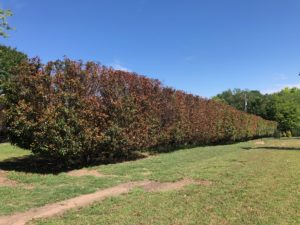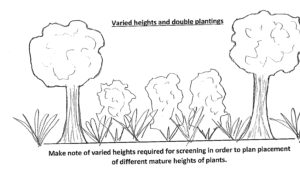Screening with plants is often necessary to provide privacy and to screen unwanted views from our homes and yards. There are some pitfalls to avoid concerning screening with plants, such as:

*DO YOUR HOMEWORK! Know your soil type, how many hours of sun each area to be planted receives and where irrigation lines can be placed. Your nursery personnel will be asking you these questions and it makes a difference in the recommendations they make.
First, determine the views that you want to screen from your view.
*Look at the view from every window and outdoor space that will benefit from screening.
*If you are trying to screen your yard from people looking IN, try to go to the areas outside your yard that will show the view that neighbors or passersby will see.
*Have someone stand in the yard and communicate with you with two-way radios or cell phones. You may want them to hold a measuring pole to indicate the height of the screen required for coverage.
*Place a stake or irrigation flag with the height range written on it in each area identified, in the location that will give the appropriate coverage.
*Consider a raised bed or raised berm to instantly increase the height of the screening, if needed. Berms must extend out 5 feet in width in all directions for each foot that they rise.
Study and prepare the area to be planted. Check the internal drainage of the soil.

*Dig a hole 1’ wide and 1’ deep in the area designated to be planted to determine the type of soil, depth of soil, and porosity of the soil. Fill the hole with water, let it drain. Fill it a second time with water and record how long it takes to drain completely. If it drains at least one inch per hour, the soil is well drained. If it drains slower, you may have to build up a berm to keep roots from rotting. Always choose plants for the type of soil you are planting them in.
*Assuming you have good internal drainage it is now time to map out the planting area. DO NOT MAKE THE BEDS TOO NARROW! Most of our screening plants get large, and one of the biggest mistakes I see is trying to fit a plant that gets wide into a narrow bed. A minimum of 8 feet in width is recommended, but a 15-foot wide bed could be required for some plants. Do your homework! Find out the mature height and spread of the plants you choose. Plan for mature size, as planting too close together may shorten the lifespan of the plant material.
*Use a water hose to “lay out” the shape of the planting area. Gentle curves are more pleasing to the eye and easier to plant than erratic curves. Remember to make the bed wide enough for the roots and the irrigation of the roots.
Plant Selection
*Determine how many hours of direct sunlight each area will receive in the summer. There is a big difference between 4 hours and 8 hours of direct sun in the summer.
*Choose plants according to the mature height and width required, with pleasing aesthetics. All plants on the same irrigation zone must also have similar watering requirements.

*If space is available, consider a “two tier” planting, with taller plants in the background. If extra height is required, consider planting a shade tree with understory plantings that will tolerate shade once the tree has grown.